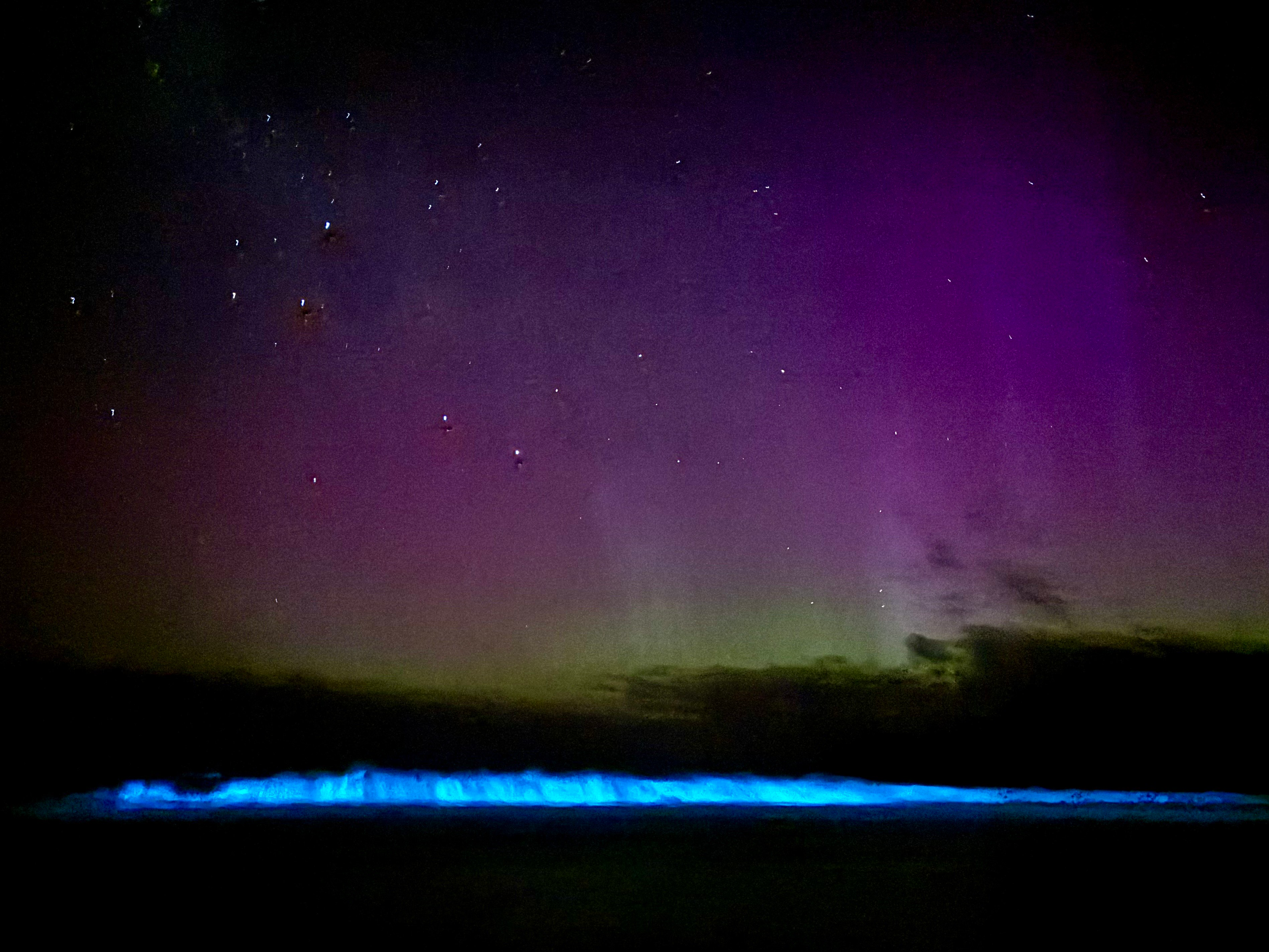Much of the world has been treated to beautiful auroras recently, accompanied by the knowledge of a hint of danger in the solar storms that cause them. In Tasmania the New Year sky show coincided with a continuing outbreak of bioluminescent Noctiluca scintillans in waters off the east coast. Some photographers have captured the two in the same images. The sparkling organisms don’t threaten civilization the way a huge solar eruption might, but that doesn’t mean there isn’t a price for that beauty.
If you like glowing things, Tasmania might be the place for you. It’s close enough to the South Magnetic Pole to get frequent auroras, its forests have a wide range of bioluminescent fungi, and its shores are increasingly visited by N. scintillans. But beauty can have a price.
In the case of the auroras, it’s the same one the rest of the world experiences – the knowledge that a more powerful version of the solar storms that create these effects could have serious consequences. Powerful geomagnetic storms, caused by events on the Sun, have blacked out large areas of North America previously, and a repeat of activity seen in the 19th century could cause global chaos.
There’s no reason to think that N. scintillans, popularly known as sea sparkles, could do anything that serious. They’re a natural, if occasional, feature of many ocean regions. Marine biologists are still unsure how climate change is affecting outbreak, but in Tasmania, there are local factors.
“At night, you just get these fabulous displays of the bioluminescence that take your breath away. They’re so beautiful,” biologist Dr Lisa-ann Gershwin told the ABC. “But it’s also a visible indicator that something is wrong.” Gershwin said the sea sparkles were not reported off Tasmania prior to the mid-1990s. They are now common enough to have featured in IFLScience stories often.

Some auroras come with beams, captured here with bioluminescence breaking on the beach.
N. scintillans are dinoflagellates. Their outbreaks have a similar cause to other forms of algae: more nutrients such as nitrogen and phosphorus than the normal inhabitants of the waters can handle. In Tasmania’s case, the most likely source is waste pouring from enormous salmon farms dotting the coastline.
Gershwin noted that jelly-like creatures known as salps have undergone a boom-bust cycle driven by these nutrients, and phytoplankton do the same thing, fertilized either by the dead salps, or directly by the same nutrients. N. scintillans then feeds on the phytoplankton.
This abundance of life might seem encouraging, but it cannot last. Excessive phytoplankton blooms deplete the oceans of oxygen, creating dead zones. Abundant N. scintillans make this worse.
One theory about why sea sparkles produce their glow is to attract predators that would feed on anything that eats them. Whether or not that’s right, they are able to multiply beyond the capacity of anything higher up the food chain to control them, at least for a time. This can produce toxic red tides, killing fish and invertebrates through a combination of ammonium build-up and loss of oxygen. When dying animals are captured, the poisons can reach up the food chain, including to us. The problem is widespread.
Humans are not directly harmed by encountering N. scintillans, at least in the short term. People who have swum through them report nothing more than a tingling sensation. However, the response of mammals more familiar with the dinoflagellates might raise concerns.
Neuroscientist Dr Emma Burrows is holidaying in southeastern Tasmania, and noticed her local beach covered in salps. “I’ve spent time on this beach all my life,” Burrows told IFLScience, “and not seen this before.”
The Tasman Peninsula is literally the end of the Earth.
Dr Emma Burrows
The next day Burrows and her family were sailing and accompanied by more playful dolphins than she has ever seen before. Her daughter declared it “the best day of my life”. As joyful and encouraging as that was, the dolphins vanished, moments before the boat hit the red-brown waters that signal abundant N. scintillans by day. Something apparently made them very reluctant to swim through the dinoflagellates.
Locals confirmed to Burrows that the abundance of salps and sea sparkles was unprecedented for the area.

Others may have captured brighter auroras or more extensive sea sparkles, but this is the product of a short beach stroll and a camera phone.
Image courtesy of Emma Burrows
When IFLScience asked Burrows if she’d photographed the N. scintillans at night she took a 10-minute walk along Clifton Beach and sent us the image above, showing how easy it is to currently see sparkles and aurora together.
Compared to the Los Angeles fires or recent catastrophic floods, a beautiful bloom deadly to fish doesn’t seem like a particularly disturbing example of human impacts on the environment. However, Burrows told IFLScience, “The Tasman Peninsula is literally the end of the Earth.” Largely surrounded by oceans, with New Zealand far off in one direction and Antarctica in another, the blooms reminded Burrows that human interference is reaching everywhere.
Moreover, with a proposal to locate more farms immediately off the beach where Burrows found the salps, this may be just the beginning.
Source Link: Tasmania Experiences A Dangerous Beauty In Sea And Sky